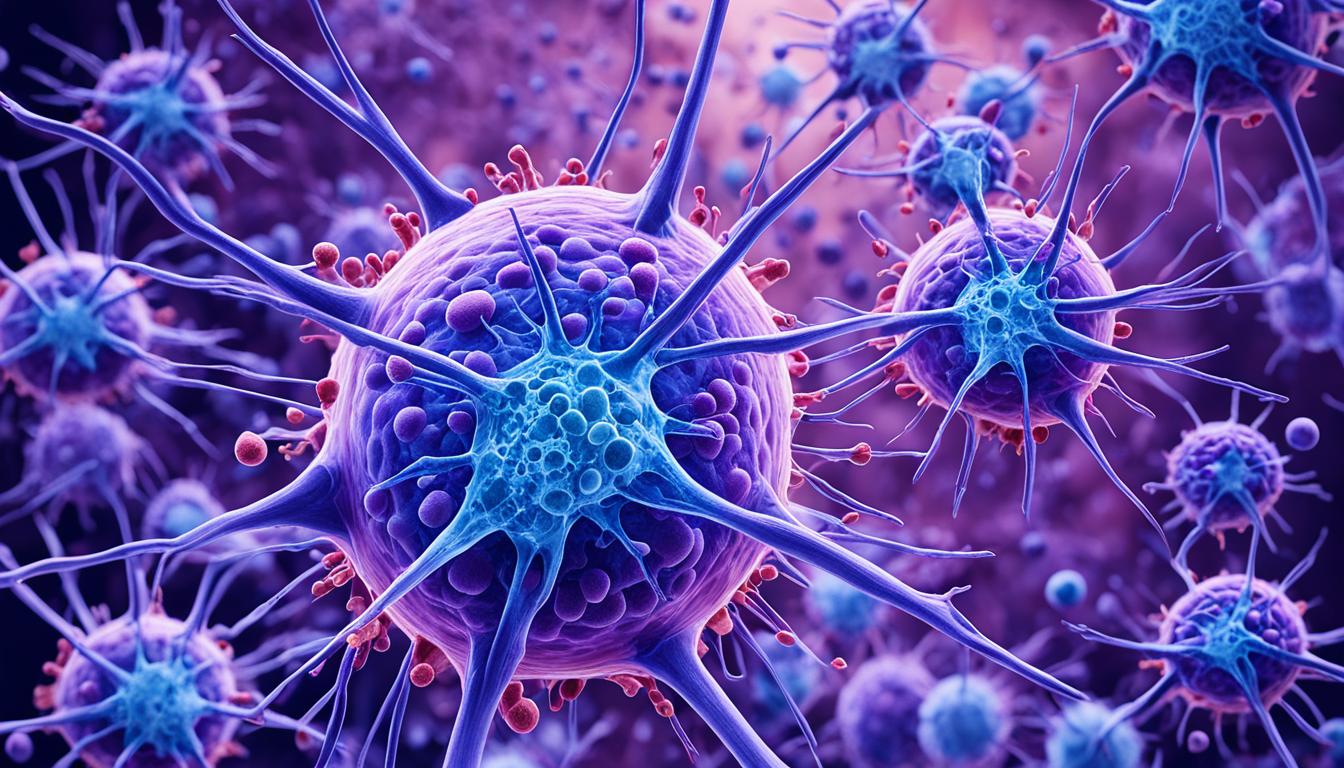Lupus, or systemic lupus erythematosus (SLE), is a disease where the immune system attacks itself. It causes inflammation and damages tissues. Its cause is unknown, but it likely mixes genetic, environmental, and hormonal factors.
Lupus mostly affects women aged 15 to 45. They suffer from joint pain, fatigue, rash, anemia, hair loss, and sometimes kidney issues. Doctors diagnose lupus by doing physical exams, running tests, and looking at medical histories.
The goal of treating lupus is to control symptoms and avoid complications. Typically, this involves using anti-inflammatory drugs, immunosuppressants, and other medicines. Now, stem cell therapy offers hope for some patients. This treatment can reset the immune system, possibly changing the disease’s course. But, success depends on age, how long a person has had lupus, and general health.
Key Takeaways:
- Lupus is an autoimmune disease affecting many body parts.
- The exact cause is unknown but is likely a mix of genes, environment, and hormones.
- Symptoms include joint pain, tiredness, rashes, anemia, hair loss, and sometimes kidney problems.
- To diagnose lupus, doctors do physical exams, tests, and gather medical histories.
- Treatment goals are easing symptoms and avoiding health problems. This includes using certain drugs.
- Stem cell therapy is a new route for lupus treatment that can reset the immune system.
- The success of stem cell therapy depends on age, disease length, and health condition.
Stem Cell Treatment for Lupus
Stem cell treatment for lupus is a new way to help reset the immune system. This method offers possible long-term benefits for those with lupus. The therapy uses stem cells to mend damaged tissues and change how the immune system acts.
When treating lupus, doctors often use Mesenchymal stem cells (MSCs). These can come from the patient’s body or from a donor. MSCs can become different cell types. They also calm down the body’s immune reactions. This can help lessen the inflammation and attacks on the body in lupus.
Autologous stem cell transplantation means using a patient’s own stem cells. On the other hand, allogeneic transplantation uses stem cells from another person. The success of this treatment in lupus depends on the patient’s age, how long they’ve had the disease, and their general health.
The Benefits of Stem Cell Treatment for Lupus
- Resetting the immune system
- Repairing damaged tissues
- Reducing inflammation and autoimmunity
- Potential long-term benefits
Different Approaches to Stem Cell Treatment for Lupus
| Approach | Description |
|---|---|
| Autologous Stem Cell Transplantation | Using the patient’s own stem cells for transplant |
| Allogeneic Stem Cell Transplantation | Using stem cells from a compatible donor for transplant |
Symptoms, Causes, and Diagnosis of Lupus
Lupus is an autoimmune disease. It has many symptoms that change from person to person. Some general symptoms are joint pain, feeling tired, a rash, not enough red blood cells (anemia), losing hair, and issues with certain organs like the kidneys.
The causes of lupus are many. It comes from a mix of genes and outside things like the sun’s rays, some drugs, and stress among others. Some genes are more common in people with lupus and make them more likely to get the disease. But, not everyone with these genes will actually get lupus. Environmental triggers have a big say too.
Diagnosing lupus takes physical exams, lab tests, and looking at past health issues. Blood tests, like the Antinuclear antibody (ANA) and anti-extractable nuclear antigen (anti-ENA) tests, are key. They find antibodies tied to lupus.
Genetic Factors
Genetics are a big part of lupus. Certain genes from the Human leukocyte antigen (HLA) family up the chance of getting the disease. They help the body decide how to react to outside triggers.
Research tells us if someone in your family has lupus, you might be more at risk. But, having these genes doesn’t mean you’ll get lupus. What you’re exposed to matters just as much.
Environmental Factors
Things in the environment can start or make lupus worse in susceptible people. This includes sunlight, certain meds, stress, infections, and certain chemicals. But, these factors don’t directly cause lupus.
How genes and the environment interact to cause lupus is complex. We still have a lot to learn.
Diagnosis
It’s not always straightforward to diagnose lupus. This is because its signs can look like other illnesses. Doctors use exams, tests, and history to figure it out.
Tests like the Antinuclear antibody (ANA) help show an immune response in lupus. Others, like the anti-double-stranded DNA (anti-dsDNA) or anti-Smith (anti-Sm), confirm the diagnosis.
Imaging tests, like X-rays, can also help see how the disease affects organs.
| Lupus Symptoms | Causes | Diagnosis |
|---|---|---|
| Joint pain | Genetic factors | Physical exams |
| Fatigue | Environmental factors | Laboratory tests |
| Rash | Autoimmune disease | Medical history review |
| Anemia | Genetic factors | Antinuclear antibody (ANA) test |
| Hair loss | Environmental factors | Anti-extractable nuclear antigen (anti-ENA) test |
| Kidney involvement |
Stem Cell Therapy for Lupus – A Promising Treatment Option
Stem cell therapy is showing new hope for those with lupus, an autoimmune disease. It aims to reset the immune system and heal tissues using stem cells. This might slow down or partly reverse lupus’s effects. The therapy’s success depends on factors like age, how long a person has had lupus, and their health.
Despite being new, early studies show stem cell therapy is promising. Some people have seen their lupus go into remission or improve greatly. Still, more research is needed to fully understand its long-term benefits and drawbacks.
This therapy uses the patient’s own stem cells or fetal stem cells. It’s a unique way to treat lupus, focusing on its root causes. As we find out more, this could be a key advancement in lupus care.

